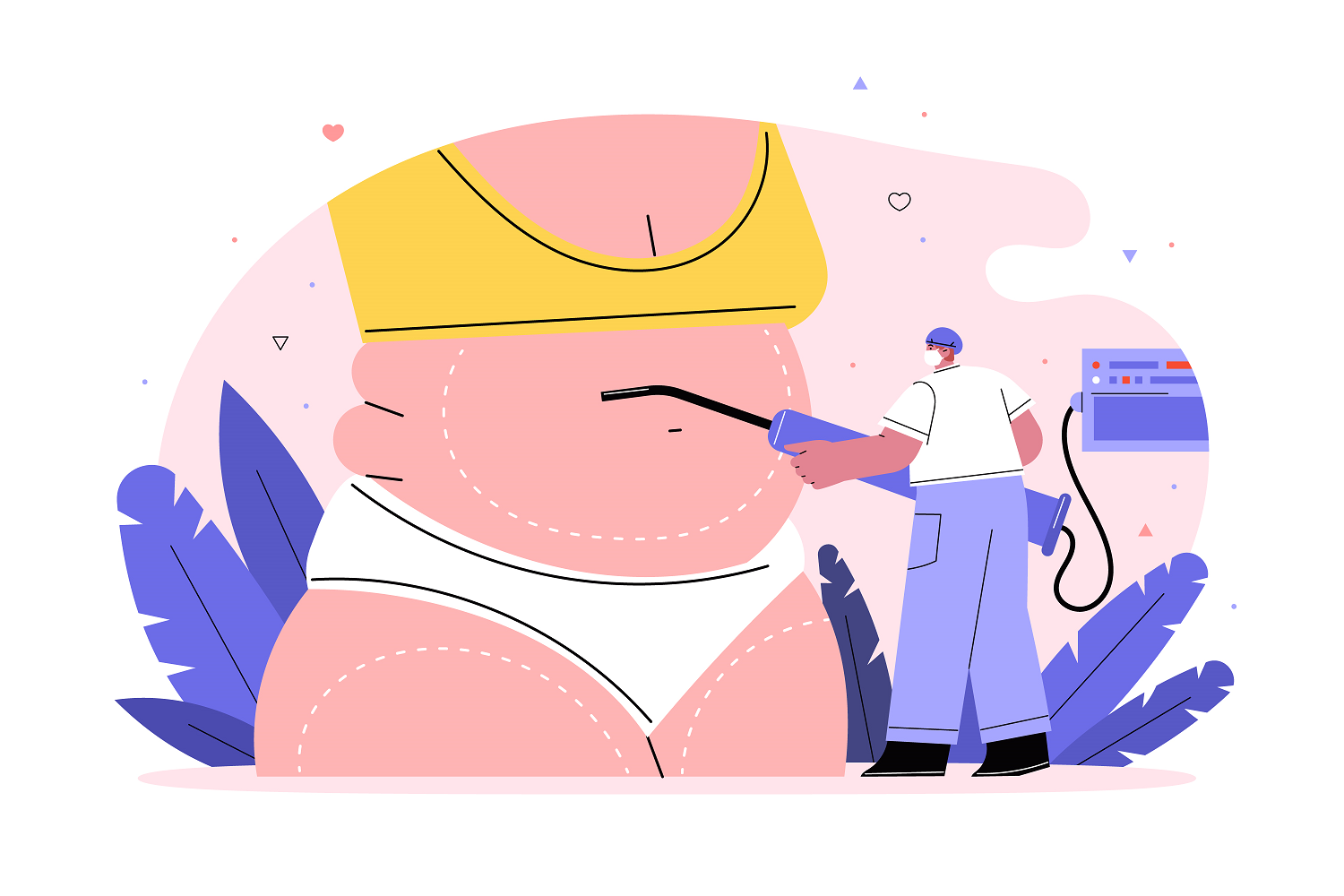The Ultimate Guide to Liposuction: What You Need to Know
Liposuction, often referred to as "lipo," has revolutionized the field of cosmetic surgery. The aim is to alter body shape, and the results are generally long-lasting if you maintain a healthy weight.
If you're considering liposuction, you're in the right place. In this comprehensive guide, we will explore all that you need to know about liposuction.
What is Liposuction?
Liposuction is a surgical procedure designed to remove small fat from specific areas of the body such as the stomach, buttocks, hips, and thighs (1). It's not a substitute for weight loss but rather a tool for body contouring. It works best in people with normal weight and in areas where the skin is tight.
Liposuction carried out for cosmetic reasons is typically not available on the NHS. However, it can sometimes be used by the NHS to treat certain health conditions, like lymphoedema, a long-term condition that causes swelling in the arms and legs and lipoedema, caused by an abnormal build-up of fat in the legs, buttocks, and thighs.
Is Liposuction Ideal for Everyone?
Liposuction is a remarkable cosmetic procedure, but not a one-size-fits-all solution. Understanding who makes an ideal candidate for liposuction is essential to ensure both safety and satisfaction with the results. Here are things to consider before going for the procedure:
- Body Mass Index (BMI): An ideal candidate should have a BMI within the range of 18.5 to 24.9. Liposuction is not a weight-loss method; it's intended for individuals close to their ideal weight who have localized pockets of fat that are resistant to diet and exercise.
- Good General Health: Candidates should be in good overall health. Severe medical conditions or chronic illnesses may increase the risks associated with surgery. Candidates need to be over 18 years of age and in good health. Those with circulation or blood flow problems, such as coronary artery disease, diabetes, or a weakened immune system should not undergo liposuction (2). A thorough medical evaluation is essential to assess a candidate's fitness for the procedure.
- Realistic Expectations: Having realistic expectations is crucial. Liposuction is a body contouring procedure, not a magic wand. Candidates should understand that while it can provide remarkable improvements, it may not achieve perfection. Open and honest communication with the surgeon about your goals is vital.
- Stable Weight: Candidates should have a stable weight for at least six months before considering liposuction. Fluctuations in weight can affect the results, so it's important to maintain a steady weight after the procedure.
- Specific Target Areas: The effectiveness of liposuction depends on the individual's body and their specific goals. Liposuction is typically most effective for areas of the body with localized pockets of stubborn fat resistant to diet and exercise. Some of the most commonly treated areas include (3):
- Abdomen, including the lower abdomen and love handles
- Thighs
- Hips and Waist
- Back
- Arms
- Neck and Chin
- Chest. For men with excess breast tissue
- Buttocks
- Knees.
It's important to note that liposuction is not a method for overall weight loss, and its effectiveness can vary from person to person. The choice of treatment areas should be discussed with a board-certified plastic surgeon, who can assess your specific needs and recommend the most appropriate areas for liposuction to achieve your desired body contouring goals.
Liposuction Procedure
Understanding the procedure can help alleviate anxiety and ensure you’re well-prepared for this journey.
1. Initial Consultation
The first step is to consult with a board-certified plastic surgeon. This includes discussing your goals, medical history, and expectations. Your surgeon will assess whether you're a suitable candidate for the procedure, provide recommendations, and answer any questions you may have.
2. Preparing for Surgery
Once you decide to proceed with liposuction, your surgeon will provide pre-operative instructions. These may include dietary guidelines, medication adjustments, and lifestyle changes to optimize your safety and results.
3. Anesthesia
On the day of your surgery, you'll receive anesthesia. Depending on the extent of the procedure and your surgeon's recommendation, you may receive local anesthesia, intravenous sedation, or general anesthesia to ensure a pain-free experience during the surgery.
4. Incision and Tumescent Solution
Small incisions, typically less than a quarter of an inch, are made near the treatment area. A tumescent solution containing saline, a numbing agent, and a vasoconstrictor is injected into the area. This solution helps reduce bleeding and makes fat removal easier.
5. Fat Removal
Through these tiny incisions, a thin tube called a cannula is inserted. The surgeon carefully maneuvers the cannula to break up and suction out excess fat cells. The sculpting process begins, creating the desired contours.
6. Closing Incisions
After removing the targeted fat, the incisions are closed with sutures or surgical tape. These incisions are strategically placed and often fade over time, leaving minimal scarring.
Liposuction Recovery and Aftercare
Recovery is a crucial aspect of liposuction, understanding the recovery and aftercare process is vital for a successful outcome (4).
Immediate Post-Operative Phase
After your liposuction procedure, you'll be closely monitored in a recovery area to ensure your safety. Expect some swelling, bruising, and mild discomfort, which are entirely normal. Your surgeon may prescribe pain medication to manage any discomfort.
To minimize the effects of swelling and bruising, keep your head elevated when resting, avoid hot baths, and apply cold compresses to the swollen areas as advised by your surgeon.
Physical Activity and Rest
While it's essential to avoid strenuous activities during the initial recovery phase, light walking is encouraged to promote circulation. Rest is equally vital, allowing your body to properly heal.
Diet and Hydration
Maintain a balanced diet rich in nutrients to support the healing process. Staying well-hydrated is also essential.
Follow-Up Appointments
Attend all scheduled follow-up appointments with your surgeon. These visits are crucial for monitoring your progress and addressing any concerns.
Expectations and Patience
Understand that visible results may take some time. Be patient and realistic about your expectations. Your new contours will gradually become more defined as swelling subsides.
Long-Term Aftercare
Maintain a healthy lifestyle with regular exercise and a balanced diet to ensure lasting results. Weight fluctuations can impact your liposuction outcome, so maintain a stable weight.
Remember, every individual's recovery experience is unique. Always follow your surgeon's specific post-operative instructions for the best results.
Benefits and Risks of Liposuction
Liposuction offers remarkable benefits, but like any surgical procedure, it comes with potential risks. Understanding both sides of the coin is crucial as you contemplate this transformative journey. The benefits of liposuction include;
- Improved Body Contours: Liposuction can sculpt and reshape your body, targeting stubborn fat deposits that diet and exercise often can't eliminate.
- Boost in Confidence: Achieving your desired body shape can enhance self-esteem and body image. Many patients report increased confidence and a more positive outlook on life after liposuction.
- Targeted Fat Removal: Liposuction allows precise targeting of specific areas, offering customized results.
- Minimal Scarring: Liposuction incisions are small, typically less than a quarter-inch in length, resulting in minimal scarring that often fades over time (5).
The potential risks of this procedure are;
- Infection: As with any surgical procedure, there is a risk of infection. Adhering to post-operative care instructions and maintaining proper hygiene is essential to minimize this risk.
- Bruising and Swelling: These are common side effects of liposuction, but they usually subside over time. Compression garments and following your surgeon's advice can help manage these issues.
- Skin Irregularities: In some cases, liposuction can result in uneven or bumpy skin. Your surgeon's expertise and technique play a significant role in reducing this risk.
- Fluid Imbalance: Liposuction involves the removal of fluids, which can sometimes lead to temporary imbalances. Proper hydration and following your surgeon's recommendations can mitigate this risk.
- Numbness or Sensation Changes: Temporary numbness or changes in sensation may occur around the treated areas. This typically resolves as the body heals.
- Serious Complications: While rare, serious complications such as blood clots, cardiac issues, or allergic reactions to anesthesia can occur. These emphasize the importance of choosing a qualified, board-certified surgeon and providing a complete medical history.
Choosing a Liposuction Surgeon
Selecting the right surgeon for your liposuction procedure is a pivotal decision that significantly influences your results and safety. Here are some things to consider before choosing a liposuction surgeon:
- Board Certification: Ensure your surgeon is board-certified in plastic surgery.
- Experience Matters: Look for a surgeon with a substantial track record in performing liposuction procedures.
- View Before-and-After Photos: Request to see before-and-after photos of patients who underwent liposuction with the surgeon. This visual evidence can give you insights into their work.
- Patient Reviews and Testimonials: Online reviews and testimonials from previous patients can offer valuable insights into a surgeon's reputation and patient satisfaction.
- Consultation: Schedule a consultation with your chosen surgeon. This meeting allows you to discuss your goals, ask questions, and gauge your communication style and professionalism.
- Hospital Privileges: Check if the surgeon has hospital privileges to perform liposuction. Hospitals vet their surgeons, adding an extra layer of credibility.
- Ask About Complications: Inquire about any complications the surgeon has encountered and how they were resolved.
- Follow Your Gut: Trust your instincts. Choose a surgeon with whom you feel comfortable and confident.
Alternatives to Liposuction
Liposuction is not the only option for body contouring. There are non-invasive alternatives that offer effective results. One popular option is CoolSculpting, and here's how it compares to liposuction:
Liposuction:
- Surgical Procedure: Liposuction is an invasive surgical procedure that requires anesthesia and incisions.
- Fat Removal: It can effectively remove larger volumes of fat in a single session, making it suitable for extensive body contouring.
- Recovery Time: Recovery may involve some downtime, and patients may experience temporary discomfort, swelling, and bruising.
- Results: Results are immediate, but it may take several weeks to see the outcome as swelling subsides.
CoolSculpting:
- Non-Invasive: CoolSculpting is a non-surgical procedure that uses controlled cooling to target and freeze fat cells.
- Fat Removal: It's ideal for smaller, localized fat deposits and may require multiple sessions for significant results.
- Minimal Downtime: There's minimal to no downtime, and most patients can return to their regular activities immediately after the procedure.
- Results: Results develop gradually over several months as the body naturally eliminates the frozen fat cells.
Choosing between liposuction and CoolSculpting depends on your goals, the amount of fat you want to remove, and your preferences regarding invasiveness and recovery time. Consult a qualified plastic surgeon or a certified CoolSculpting provider to determine the most suitable option for your body contouring needs.
Conclusion
In conclusion, liposuction is a powerful tool for achieving the body you desire. This guide has provided a comprehensive overview of the procedure, from its benefits and risks to recovery and alternatives. With this knowledge, you can make an informed decision about whether liposuction is right for you. Remember that consulting with a qualified surgeon is the next crucial step on your journey to a more confident you.
Also Read;
- The Latest Trends in Anti-Aging Treatments and Skincare
- How Social Media is Influencing Brazilian Butt Lifts
- Lip Blushing: The Art of Semi-Permanent Lip Tatoo
- Thread Lift: Elevating Your Beauty without Surgery
- Body Inclusivity Movement







Comments (0)